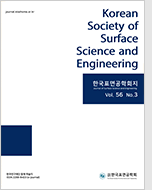
- Past Issues
- e-Submission
-

2021 Impact Factor 1.766
5-Year Impact Factor 1.674
Editorial Office
- +82-2-563-0935
- +82-2-558-2230
- submission@kssse.or.kr
- https://www.kssse.or.kr/

2021 Impact Factor 1.766
5-Year Impact Factor 1.674
The Korean Society of Surface Science and Engineering 2024;57(1):49-56. Published online: Feb, 28, 2024
DOI : doi.org/10.5695/JSSE.2024.57.1.49
Superhydrophobic surfaces have been expected to be able to provide considerable performance improvements and introduce innovative functions across diverse industries. However, representative methods for fabricating superhydrophobic surfaces include etching the substrate or attaching nano-sized particles, but they have been limited by problems such as applicability to only a few materials or low adhesion between particles and substrates, resulting in a short lifetime of superhydrophobic properties. In this work, we report a novel coating technique that can achieve superhydrophobicity by electrophoretic deposition of aluminum nitride (AlN) nanopowders and their self-bonding to form a surface structure without the use of binder resins through a hydrolysis reaction. Furthermore, by using a water-soluble adhesive as a temporary shield for the electrophoretic deposited AlN powders, hierarchical aluminum hydroxide structures can be strongly adhered to a variety of electrically conductive substrates. This binder-free technique for creating hierarchical structures that exhibit strong adhesion to a variety of substrates significantly expands the practical applicability of superhydrophobic surfaces.
Keywords Superhydrophobic surface; Aluminum nitride nanopowder; Electrophoretic deposition; Hydrolysis reaction